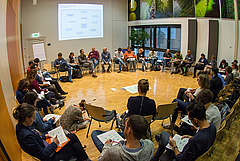Over 240 participants at iDiv Annual Conference

'Brainstorming session' during iDiv Annual Conference (photo: Stefan Bernhardt).

The keynote lecture was given by Prof Jordi Bascompte, University of Zurich (photo: Stefan Bernhardt).

During 'demonstration sessions', iDiv scientists could get their hands on their colleagues' research tools (photo: Stefan Bernhardt).

Posters were presented in the entrance hall of 'Kubus' (photo: Stefan Bernhardt).
Note for the media: Use of the pictures provided by iDiv is permitted for reports related to this media release only, and under the condition that credit is given to the picture originator.
Leipzig. This year’s iDiv Annual Conference brought together iDiv scientists from 19 to 20 September in “Leipziger Kubus”. 241 participants from different institutions across Germany and with different scientific backgrounds joined this internal meeting to discuss burning questions of integrative biodiversity research. “We heard an amazing keynote, got contributions from very different disciplines and enjoyed a very pleasant atmosphere during the two days here”, said Prof Ulrich Brose, chair of the organisation committee.
During the first day, over 20 inspiring talks gave insight into research conducted within the iDiv consortium. Topics comprised sustainability, evolution, social science and plants & -omics. The afternoon keynote by Prof Jordi Bascompte about plant-animal mutualistic networks preceded the informal get-together with wine and cheese in the evening.
During the second day the programme continued with another 20 talks on experiments & interactions, big data & scales, techniques & traits and modelling & networks & statistics, followed by four brainstorming sessions about MyDiv and three taproot approaches. The day was completed by several ignite talks and the final plenary.
“We tested for the first time a new presentation format called ‘ignite talks’”, said Scientific Coordinator Dr Rebecca Thier-Lange, who organised the conference together with her team. These talks gave early career scientists the possibility to update the audience on the current status of their research projects. And they had a very special format: Every slide was visible for 15 seconds only before the presentation automatically switched to the next slide. “We are very happy that so many scientists took the challenge and presented their research in this ‘speed-talk’ format”, said Thier-Lange. “The quality of these talks was amazing and we could see that all presenters had taken a great effort to prepare their talks. In general, we feel that the conference fulfilled its mission and gave a nice opportunity to all scientists to interact and exchange their ideas on future collaborative projects. We are now collecting feedback from the participants, which we will use to conceptualise the conference next year.”
Here you can find more pictures from the conference. 



